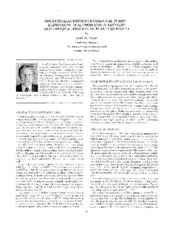| dc.contributor.other | International Pump Users Symposium (7th : 1990) | |
| dc.creator | Mayes, Jared D. | |
| dc.date.accessioned | 2017-10-05T21:41:28Z | |
| dc.date.available | 2017-10-05T21:41:28Z | |
| dc.date.issued | 1990 | |
| dc.identifier.uri | https://hdl.handle.net/1969.1/164262 | |
| dc.description | Lecture | en |
| dc.description | pg. 93 | en |
| dc.description.abstract | Centrifugal pump design plays an essential role in the safe operation of any refinery or chemical processing plant. In analyzing the performance of centrifugal pumps, pump operating time to failure is almost always limited to that of the shaft mechanical seal. Mechanical seals and their sophisticated supporting systems have become more complicated as the pumping industry perseveres in its efforts to produce satisfactorily seal life. Numerous research projects have proceeded, many papers demonstrating seal leakage have been presented, but the overall progress in extending seal life has not been to everyone’s satisfaction. A viable and important option, therefore, is a centrifugal pump that does not require mechanical seals. A magnetically driven sealless pump is such a machine. It conveys liquid safely with no dynamic seal between the motor shaft and the impeller(s). There is no potential leakage path, since prime mover energy is transmitted magnetically through the pressure casing wall. Magnet drive pumps are capable of producing flow rates to 5000 gpm and heads to 1000 ft. Temperatures ranging from -100°F to + 850°F, and system pressure to 5000 psi can be accommodated without the need for any ancillary services or supporting systems. Likewise, the magnet drive pump is excellent for high vacuum services where sealing mechanically may prove extremely difficult. Sealless pumps generally are thought to be intolerant of solids in pumpage. However, magnet drive pump designs are now available with substantially improved performance in abrasive services. The magnet drive centrifugal pump is simply a conventional centrifugal pump with an integral magnetic coupling imposed between the driver and the liquid end. This magnetic coupling replaces the seal chamber or stuffing box in such a way that the liquid end is made hermetic. The mechanical seal or packing is eliminated and the only seal is a stationary gasket or O-ring. The mechanical design features are outlined for the sealless magnet drive centrifugal pump along with the advantages and occasional limitations of this type of machine com-pared with mechanically sealed pumps. Particular reference is made to proven applications and to the significant increase in recent years in the efficiency of and power available in magnetic drives. | en |
| dc.format.medium | Electronic | en |
| dc.format.mimetype | application/pdf | |
| dc.language.iso | en | |
| dc.publisher | Turbomachinery Laboratories, Department of Mechanical Engineering, Texas A&M University | |
| dc.relation.ispartof | Proceedings of the 7th International Pump Users Symposium | en |
| dc.subject.lcsh | Pumping machinery | en |
| dc.title | Magnetically Driven Centrifugal Pumps Eliminating Seal Problems In Refinery And Chemical Processing Plant Equipment | en |
| dc.type.genre | Presentation | en |
| dc.type.material | Text | en |
| dc.identifier.doi | https://doi.org/10.21423/R1568X | |


